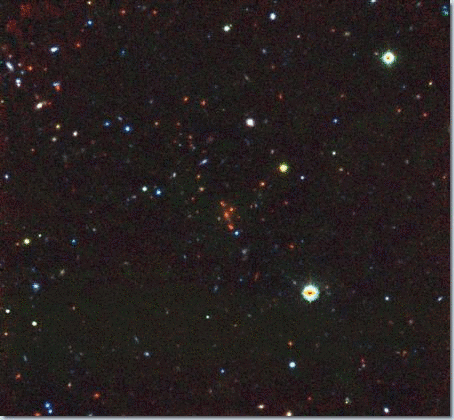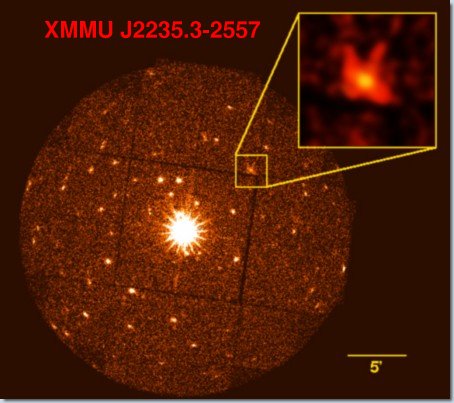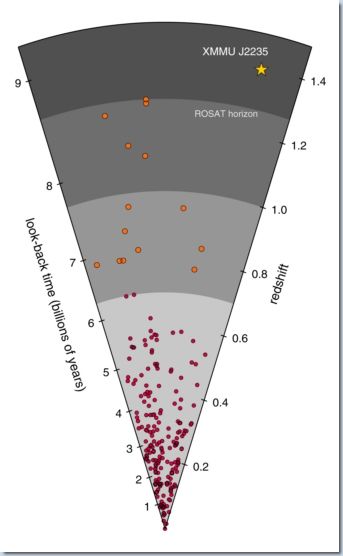Galaxy Clusters A. Schwope (AIP)
Clusters of galaxies are the largest gravitationally bound structures in the Universe. The current paradigm of structure formation
in the Universe assumes that the seeds of the structures that are visible today originate from tiny ripples in the matter distribution
that were present already in the very early Universe, soon after it came into existence.
The attractive force of gravity is responsible for the growth from small to large structures so
that the most massive objects are observed nowadays. How exactly this happens is one of the hot topics in
current observational and theoretical astrophysics. Clusters of galaxies are thought to reside at the density peaks of the
universal matter distribution and form deep potential wells that helps keeping them in shape.
No galaxy cluster is visible for the naked eye but can be recognized even with a moderately sized telescope. As the name suggests,
clusters of galaxies appear as a group of associated galaxies, very often centred on a dominant elliptical galaxy.
Clusters may contain several thousand member galaxies, each of those might be comparable in size and mass to our own Milky Way galaxy.
They rotate around their common centre of mass like the bees in a swarm. Studying their motion revealed the surprising result that the mass
in the clusters must be considerably larger than the sum of mass of all the member galaxies. Hence, some form of matter not visible to the eye must exist.
When galaxy clusters were observed with an X-ray telescope for the first time, another surprising observation was made. Instead of the member galaxies
the whole sky region that was occupied cluster member galaxies was emitting X-rays.
| X-ray emission of a cluster |
 |
Superposition of a XMM-Newton image with a VLT image.
The little red dots belong top the cluster which intergalactic cloud of gas emits X-ray.
|
| photo ESA / AIP / ESO |
The clusters appeared as X-ray nebulae, i.e. as single closed entities. This property was found to be enormously helpful when searching for clusters of galaxies in the X-ray sky because one only needs to look for X-ray nebulae instead of counting individual galaxies in a certain sky area with the risk of identifying just chance projections.
The X-ray gas has a certain mass which was found to dominate over the mass stored in galaxies but insufficient to solve the missing mass problem
described above. After all, there is strong evidence for another form of mass dominating the mass budget of galaxy clusters. It does not emit
electromagnetic radiation (usually termed ‘light’, be it X-rays or optical radiation) but solely interacts gravitationally. These properties gave
rise to dub it the mysterious
Dark Matter.
| X-ray emission of a cluster |
 |
|
Discovery of a Cluster near the galaxy NGC 7314 (image center)
|
| Image ESA / AIP.
|
Galaxy clusters are luminous in X-rays and can be observed over large large distances and hence large parts of the cosmic history. Despite being bright
they have not yet cooled down due to their enormous energy reservoir and one can observe them as they were formed. This ‘anti-aging’ property makes
them attractive targets for astrophysics and cosmology.
The ARCHES project aims to establish a high-quality cluster catalogue for scientific exploitation based on data from the world-leading X-ray observatory
for this type of science, XMM-Newton. Serendipitously detected X-ray nebulae are regarded as prime cluster candidates. Their distance and their
luminosity can be determined if their cosmological redshift can be measured.
| Galaxy cluster repartition |
 |
|
Repartition of the well known galaxy clusters. The latest discovered cluster is on the top right of the picture.
|
| Courtesy of ESO |
This step involves a clever combination of X-ray and optical catalogue
data by a software tool developed here and called the Integrated Cluster Finder.
back


